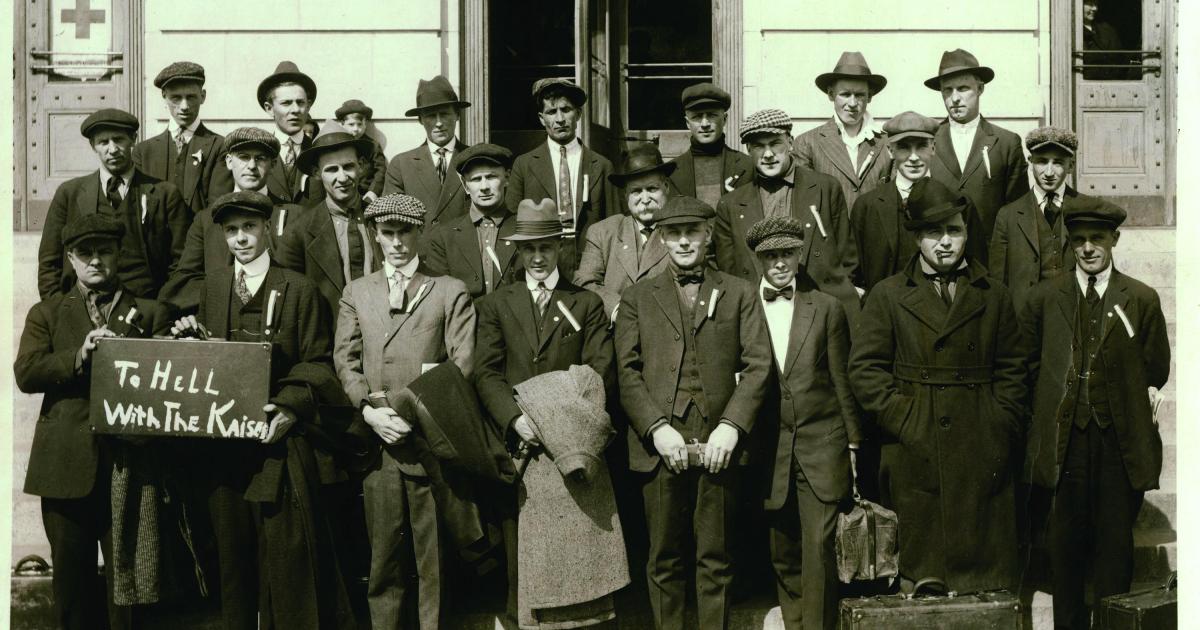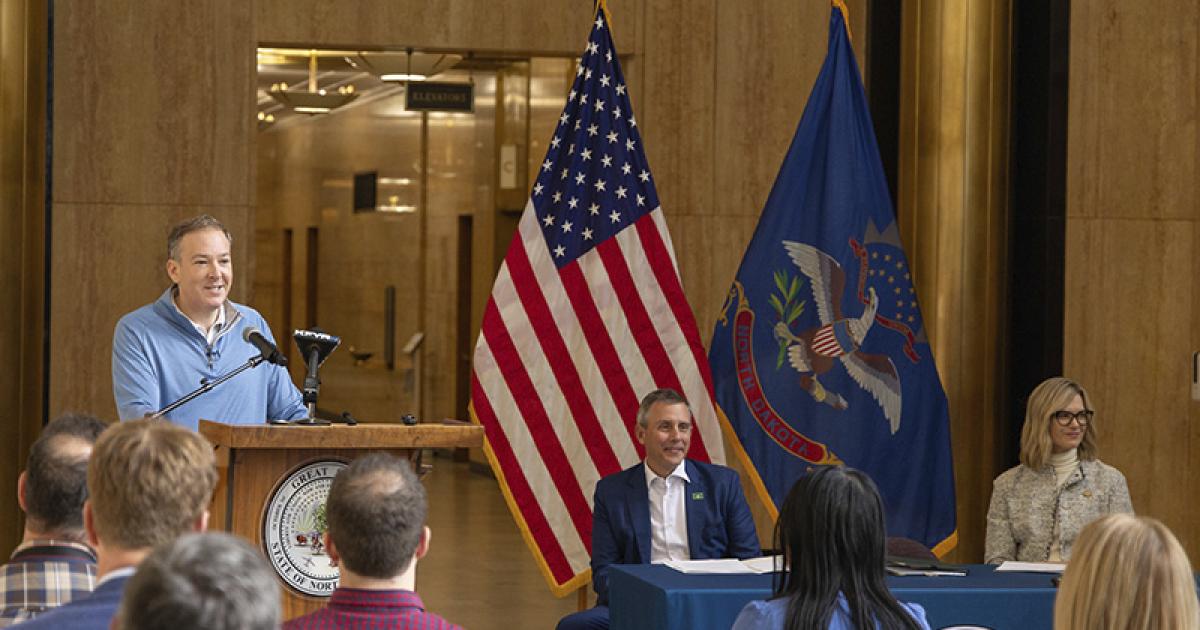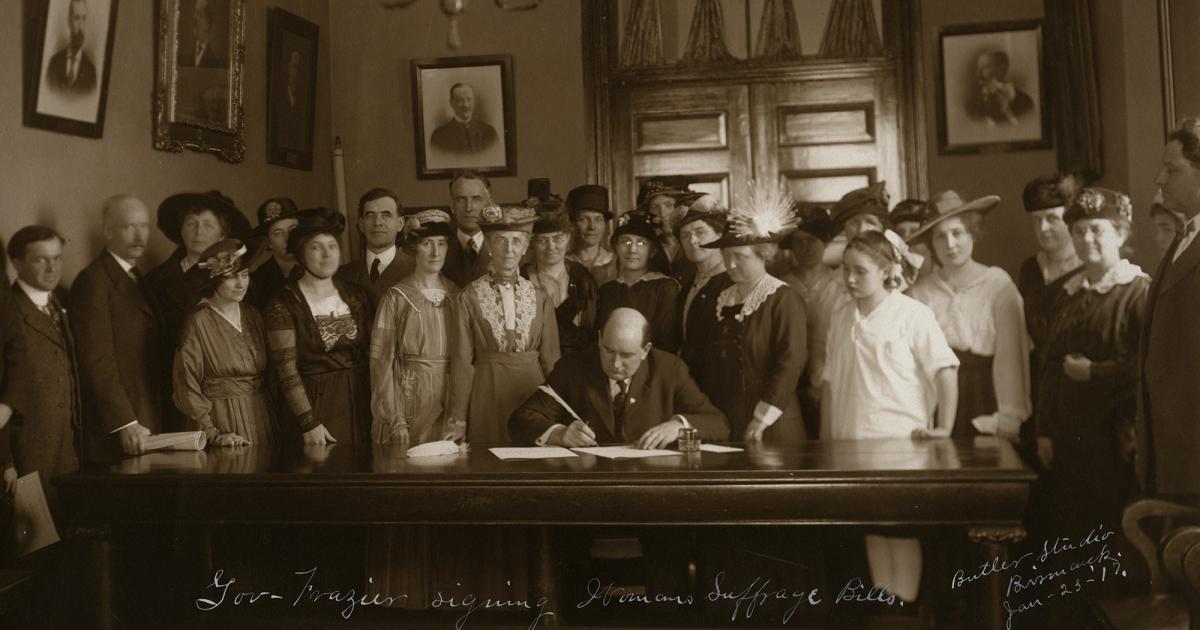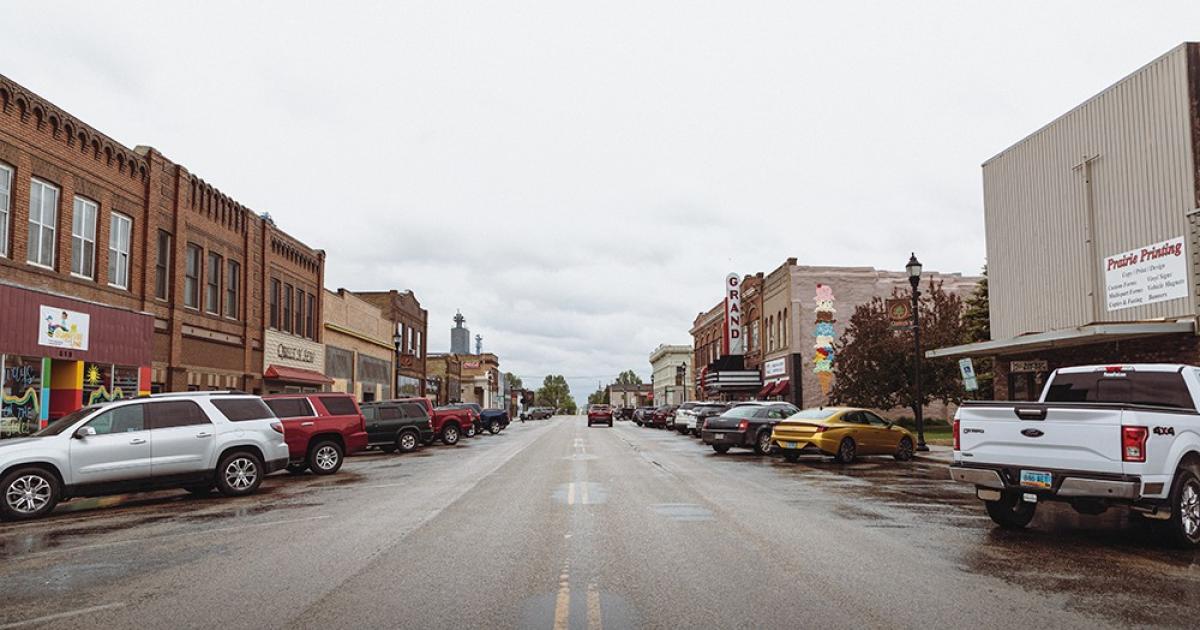N.D. WWI Centennial Committee community events
This autumn, North Dakotans join the worldwide solemn salute to the great sacrifices made during World War I (WWI), which ended 100 years ago. In North Dakota, this WWI centennial observance has spanned 2017-18. Gov. Doug Burgum issued a proclamation designating April 6, 2017, as World War I Day in North Dakota, as April 6, 1917, marked the entry of the United States into WWI 100 years ago.
Burleigh County men assembled for a group photo in Bismarck on March 29, 1918, just before deployment to serve in WWI. STATE HISTORICAL SOCIETY OF N.D. PHOTO
WWI started in Europe in the summer of 1914, with the assassination of the Austria-Hungary archduke. That nation aligned with Germany in commencing warfare against Allied Powers, principally including the Russian Empire, French Republic and Great Britain. Germany’s persistent attacks on United States ocean vessels and threats to U.S. territorial integrity prompted the U.S. to enter WWI in April 1917. The “Great War” ended on Nov. 11, 1918.
To coordinate the state’s focus on the WWI centennial, the North Dakota World War One Centennial Commission has been established. The commission has been educating the public about the course of the war as it affected North Dakota; honoring the heroism and sacrifice of Americans and the 30,000 North Dakotans serving in the war; and conducting several programs commemorating the WWI centennial.
“The veterans of World War I were American heroes,” says Darrell Dorgan, chairman of the commission, which is made up of 30 North Dakota public officials, history scholars and community leaders. Dorgan points out that 117,000 American soldiers died during WWI service; 1,300 of these casualties were North Dakotans.
“Today, a century after they entered the trenches, their sacrifices have been largely forgotten. That is why nationally, and in North Dakota, we are marking the centennial,” he continued.
This state – comparable in other states – is helping the United States World War I Centennial Commission conduct a nationwide campaign of education and tribute for the sacrifices and achievements of WWI.
This autumn, through Nov. 11, the state commission, with local supporters, will be participating in local forums, where WWI and North Dakota will be examined. (See sidebar for schedule of forums.)
LETTERS FROM THE GREAT WAR
The North Dakota WWI Commission, the North Dakota Newspaper Association and history students at the University of Mary, under the direction of Dr. Joseph Stuart, undertook State Historical Society archives research, locating letters written from WWI soldiers to family and friends in North Dakota.
Nearly 100 of these letters have been transcribed for publication and made available to newspapers and news outlets. Each letter, in its own way, documents authentic firsthand observations of what actually happened in the many venues where this war was fought. Three are presented below.
ROUSE LETTER
Note: Captain Charles L. Rouse wrote a letter to an unknown recipient on Sept. 25, 1918, from somewhere in France. It was published in the Crosby Journal, Divide County, Oct. 25, 1918; following is a portion of that letter:
It has been quite some time since I have written you, but I haven’t had scarcely a bit of mail from the states since the first part of July.
On July 18 my Division took part in the big attack. We advanced directly on Soissons in the Marne and the second day out I got hit in the leg with a machine gun bullet. I went back to the First Aid Station and then went back to the line that night. The third day out, July 20, I got gassed and then went to a Base Hospital in Nantes. I stayed there a few weeks and was then sent to where I am now, a Depot Division, marked class B, which means I shall be here a few months until I am restored to class A and fit for duty at the front.
Am feeling fine now and as good as ever except for a few burns which aren’t healed up yet from the gas. You know, when this mustard gas strikes anything wet it forms sulphuric acid and the result is you get quite a burn.
So after being shifted from one station to another so often after coming from a hospital, one’s mail is lost in the crowd. I must have a bunch of it some place, which will be turning up right soon.
You see some great sights going over the top, as well as feeling some queer sensations. It’s hell all right but quite interesting and I’ll have some great tales to tell you when it’s all over. And the way everyone is walloping the Hun it looks mighty promising. But there will still be some good fighting…
JONES LETTER
Note: This letter was written by J.H. Jones from a battlefield in France. It was published in the Manning News, Dunn County, Oct. 24, 1918; following is portion of that letter:
On the Battlefield, France
September 21, 1918
Friend Bessie:
Yours received and was sure glad to hear from you.
We have been in another big drive as you doubtless have seen by the papers and have won another big strip of ground held by the Hun for four years. At present I am leaning against a cannon we captured. We sure did get lots of guns and ammunition and about 20,000 prisoners.
We advanced about 8 miles here and are only about 20 miles from Metz. Have been moving day and night, in rain, hail, and cold mud, knee deep at times. Found lots of dead Germans and Yanks while the ambulances carried lots of poor devils to the hospital. It was sure an awful drive and the reward was well earned.
We have at last stopped for a little rest in dugouts and trenches formerly held by the Hun for more than four years. Everyone is on nettles and talks of nothing but the big victory. There were at least 200,000 here. We hit them on five sectors of a forty mile front and beat them bad. The barrage was opened at one A.M. and the boys went over the top at five A.M.
The guns were 3, 3 1-2, 4, 6, 9, 10, 16, and 20 inch and machine guns. Rifles and everything you can think of was used. Oh, it was terrible but we will yet make them glad to agree to a U.S. Peace.
The Wagoners, Tank, Truck, Auto, Ambulance, Ammunition, and Infantry trams were on the move day and night with us. We had no sleep for days, and eats were scarce, but it was endured with the consolation that we were winning one of the greatest battles of the war.
Sure hope everything is fine and dandy over there, and that a fine crop will be made and that the war will soon be at an end…
Sincerely,
J.H. Jones.
ANGLISS LETTER
Note: Ernest Angliss wrote three short letters from France to his dad, mother, and sister. The letters were published in the Dickinson Press, Stark County, Oct. 10, 1918; presented here is the letter to his mother.
On active service Over Here,
September 17, 1918
My Dear Little Mother:
Well, Sweetheart, it has been quite awhile since I wrote last, but you will by the papers the reasons of it – you will read of the big drive under command of our great general. I saw Harold Poor a few days ago. He had just returned from the hospital, but was looking first rate. Did you get the Hun belt buckle and watch? Well mother dear, there is a German helmet on the road for you; I sent it yesterday and took it to the postoffice myself, so it is on its way to you. I carried it on my motorcycle so it is muddy and will need some cleaning. You will see where the shrapnel bullets struck it by the dents. The red paint spots are camouflage. It is about as good a helmet as I could pick up. The boys made great fun of me for carrying it around, but I told them plump and plain, “My mother wants one and believe me she is going to get it.” Where I was hit by the Ford ambulance on my hand, the bone budged up and has never gone down, so there is a bump there now. Well mother dear, I must ring off; will write soon again. With heaps of love to you.
Just - Ernest










